Acute Effects of Red Chili, a Natural Capsaicin Receptor Agonist, on Gastric Accommodation and Upper Gastrointestinal Symptoms in Healthy Volunteers and Gastroesophageal Reflux Disease Patients
Abstract
:1. Introduction
2. Materials and Methods
2.1. Subjects
2.2. Methods
2.3. Statistical Analysis
3. Results
3.1. The Gastric Accommodation after Chili and Placebo Ingestion
3.2. The Gastric Volume after Chili and Placebo Ingestion
3.3. Postprandial Upper Gastrointestinal Symptom Scores after Chili and Placebo Ingestion
4. Discussion
5. Conclusions
Author Contributions
Funding
Conflicts of Interest
References
- Holzer, P. Transient receptor potential (TRP) channels as drug targets for diseases of the digestive system. Pharmacol. Ther. 2011, 131, 142–170. [Google Scholar] [CrossRef] [PubMed] [Green Version]
- Aniwan, S.; Gonlachanvit, S. Effects of Chili Treatment on Gastrointestinal and Rectal Sensation in Diarrhea-predominant Irritable Bowel Syndrome: A Randomized, Double-blinded, Crossover Study. J. Neurogastroenterol. Motil. 2014, 20, 400–406. [Google Scholar] [CrossRef] [PubMed] [Green Version]
- Patcharatrakul, T.; Gonlachanvit, S. Chili Peppers, Curcumins, and Prebiotics in Gastrointestinal Health and Disease. Curr. Gastroenterol. Rep. 2016, 18, 19. [Google Scholar] [CrossRef] [PubMed]
- Kang, J.Y.; Tay, H.H.; Guan, R. Chronic upper abdominal pain: Site and radiation in various structural and functional disorders and the effect of various foods. Gut 1992, 33, 743–748. [Google Scholar] [CrossRef] [Green Version]
- Rodriguez-Stanley, S.; Collings, K.L.; Robinson, M.; Owen, W.; Miner, P.B., Jr. The effects of capsaicin on reflux, gastric emptying and dyspepsia. Aliment. Pharmacol. Ther. 2000, 14, 129–134. [Google Scholar] [CrossRef] [PubMed]
- Gonzalez, R.; Dunkel, R.; Koletzko, B.; Schusdziarra, V.; Allescher, H.D. Effect of capsaicin-containing red pepper sauce suspension on upper gastrointestinal motility in healthy volunteers. Dig. Dis. Sci. 1998, 43, 1165–1171. [Google Scholar] [CrossRef]
- Horowitz, M.; Wishart, J.; Maddox, A.; Russo, A. The effect of chilli on gastrointestinal transit. J. Gastroenterol. Hepatol. 1992, 7, 52–56. [Google Scholar] [CrossRef]
- Kochhar, K.P.; Bijlani, R.L.; Sachdeva, U.; Mahapatra, S.C.; Padhy, A.K.; Tandon, R.K. Gastro-intestinal effects of Indian spice mixture (Garam Masala). Trop. Gastroenterol. 1999, 20, 170–174. [Google Scholar]
- Lee, K.J.; Vos, R.; Tack, J. Effects of capsaicin on the sensorimotor function of the proximal stomach in humans. Aliment. Pharmacol. Ther. 2004, 19, 415–425. [Google Scholar] [CrossRef]
- Tc, N.G.; Gonlachanvit, S. Effects of capsaicin containing chili on gastroesophageal acid reflux (GER) and gastric emptying (GE) in patients with GER symptoms. J Gastroenterol. Hepatol. 2008, 23, A5. [Google Scholar]
- Bhat, Y.M.; Bielefeldt, K. Capsaicin receptor (TRPV1) and non-erosive reflux disease. Eur. J. Gastroenterol. Hepatol. 2006, 18, 263–270. [Google Scholar] [CrossRef] [PubMed]
- van Lelyveld, N.; Scheffer, R.; Mundt, M.; Samsom, M. Partial gastric volumes and upper abdominal sensations in functional dyspeptic and GERD patients: A 3D ultrasonographic study. Am. J. Gastroenterol. 2006, 101, 1845–1852. [Google Scholar] [CrossRef] [PubMed]
- Gonlachanvit, S.; Maurer, A.H.; Fisher, R.S.; Parkman, H.P. Regional gastric emptying abnormalities in functional dyspepsia and gastro-oesophageal reflux disease. Neurogastroenterol. Motil. 2006, 18, 894–904. [Google Scholar] [CrossRef]
- Scheffer, R.C.; Gooszen, H.G.; Hebbard, G.S.; Samsom, M. The role of transsphincteric pressure and proximal gastric volume in acid reflux before and after fundoplication. Gastroenterology 2005, 129, 1900–1909. [Google Scholar] [CrossRef] [PubMed]
- Vasavid, P.; Chaiwatanarata, T.; Gonlachanvit, S. The Reproducibility of Tc-Pertechnetate Single Photon Emission Computed Tomography (SPECT) for Measurement of Gastric Accommodation in Healthy Humans: Evaluation of the Test Results Performed at the Same Time and Different Time of the Day. J. Neurogastroenterol. Motil. 2010, 16, 401–406. [Google Scholar] [CrossRef] [Green Version]
- Penagini, R.; Hebbard, G.; Horowitz, M.; Dent, J.; Bermingham, H.; Jones, K.; Holloway, R.H. Motor function of the proximal stomach and visceral perception in gastro-oesophageal reflux disease. Gut 1998, 42, 251–257. [Google Scholar] [CrossRef]
- Vu, M.K.; Straathof, J.W.; vd Schaar, P.J.; Arndt, J.W.; Ringers, J.; Lamers, C.B.; Masclee, A.A. Motor and sensory function of the proximal stomach in reflux disease and after laparoscopic Nissen fundoplication. Am. J. Gastroenterol. 1999, 94, 1481–1489. [Google Scholar] [CrossRef]
- Pauwels, A.; Altan, E.; Tack, J. The gastric accommodation response to meal intake determines the occurrence of transient lower esophageal sphincter relaxations and reflux events in patients with gastro-esophageal reflux disease. Neurogastroenterol. Motil. 2014, 26, 581–588. [Google Scholar] [CrossRef]
- Szallasi, A.; Blumberg, P.M. Vanilloid (Capsaicin) receptors and mechanisms. Pharmacol. Rev. 1999, 51, 159–212. [Google Scholar]
- Pingle, S.C.; Matta, J.A.; Ahern, G.P. Capsaicin receptor: TRPV1 a promiscuous TRP channel. In Handbook of Experimental Pharmacology; Springer: Berlin/Heidelberg, Germany, 2007; pp. 155–171. [Google Scholar]
- Tominaga, M.; Tominaga, T. Structure and function of TRPV1. Pflug. Archiv. Eur. J. Physiol. 2005, 451, 143–150. [Google Scholar] [CrossRef]
- Tack, J.; Piessevaux, H.; Coulie, B.; Caenepeel, P.; Janssens, J. Role of impaired gastric accommodation to a meal in functional dyspepsia. Gastroenterology 1998, 115, 1346–1352. [Google Scholar] [CrossRef]
- Department of Thai Traditional and Alternative Medicine MoPH. Knowledge Library, Pepper Monograph. 2020. Available online: http://ttdkl.dtam.moph.go.th/Module1/frmc_show_monograph.aspx?h_id=MTg4Mg%3d%3d (accessed on 31 October 2020).
- Führer, M.; Hammer, J. Effect of repeated, long term capsaicin ingestion on intestinal chemo- and mechanosensation in healthy volunteers. Neurogastroenterol. Motil. 2009, 21, 521-e7. [Google Scholar]
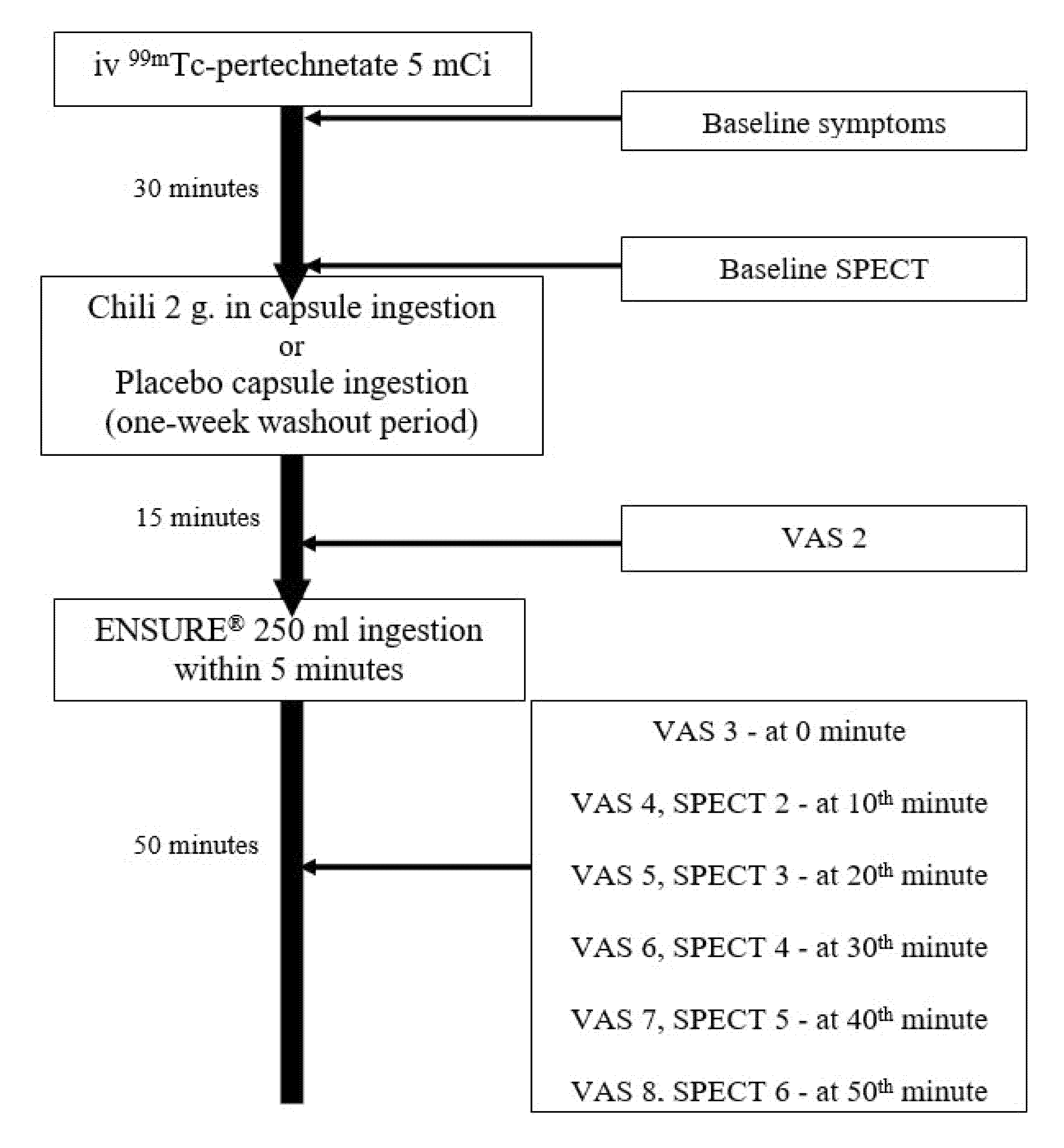
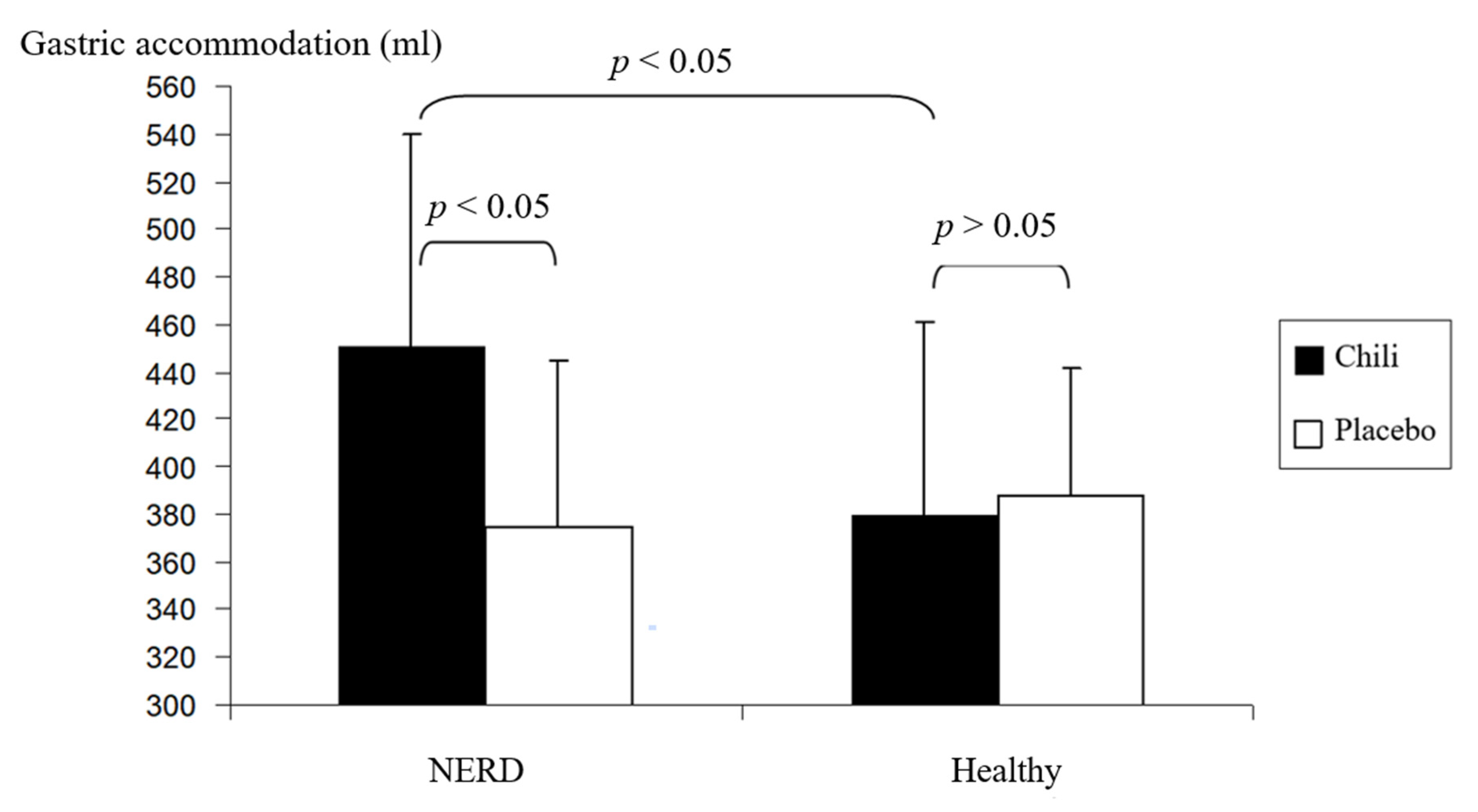
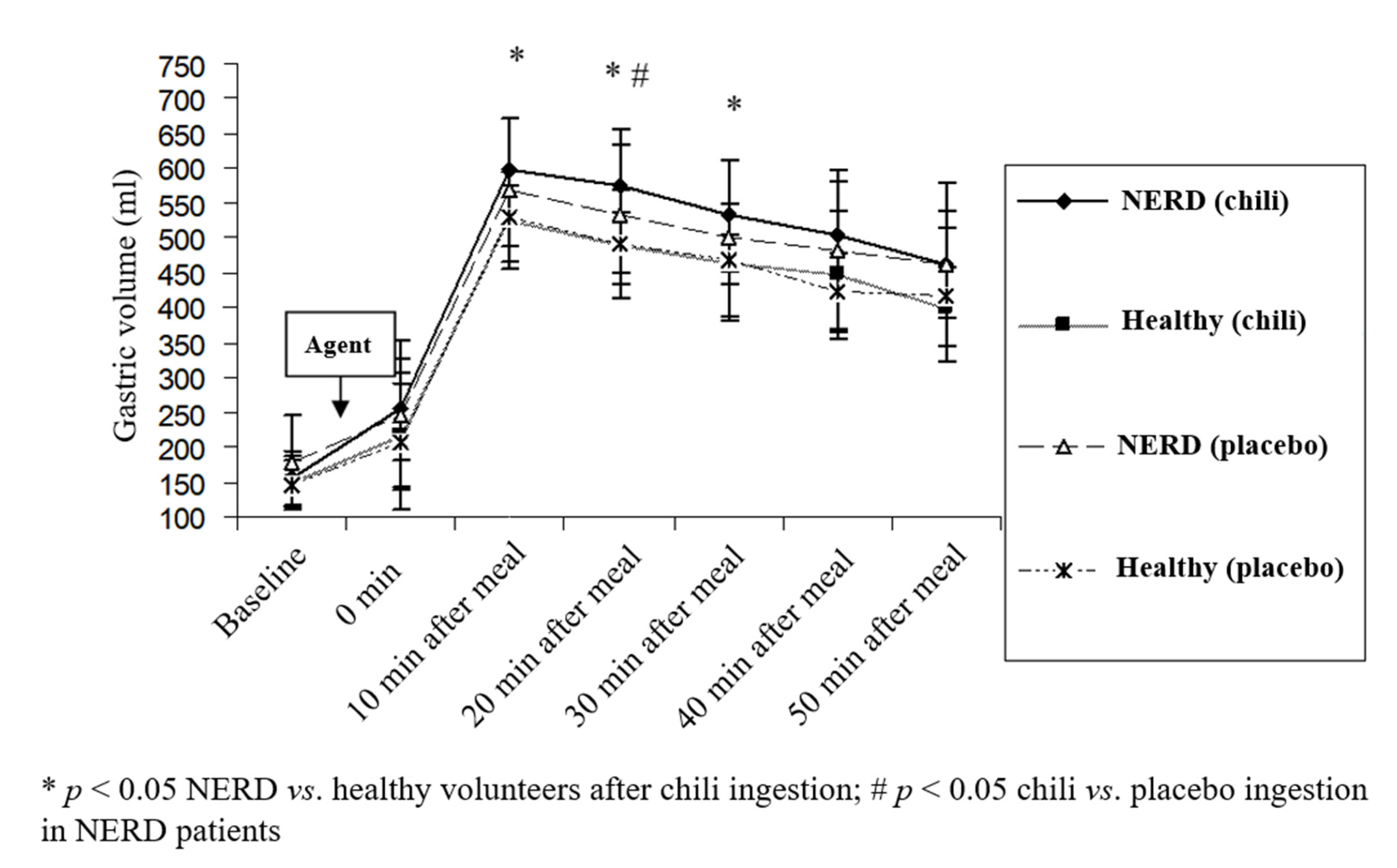
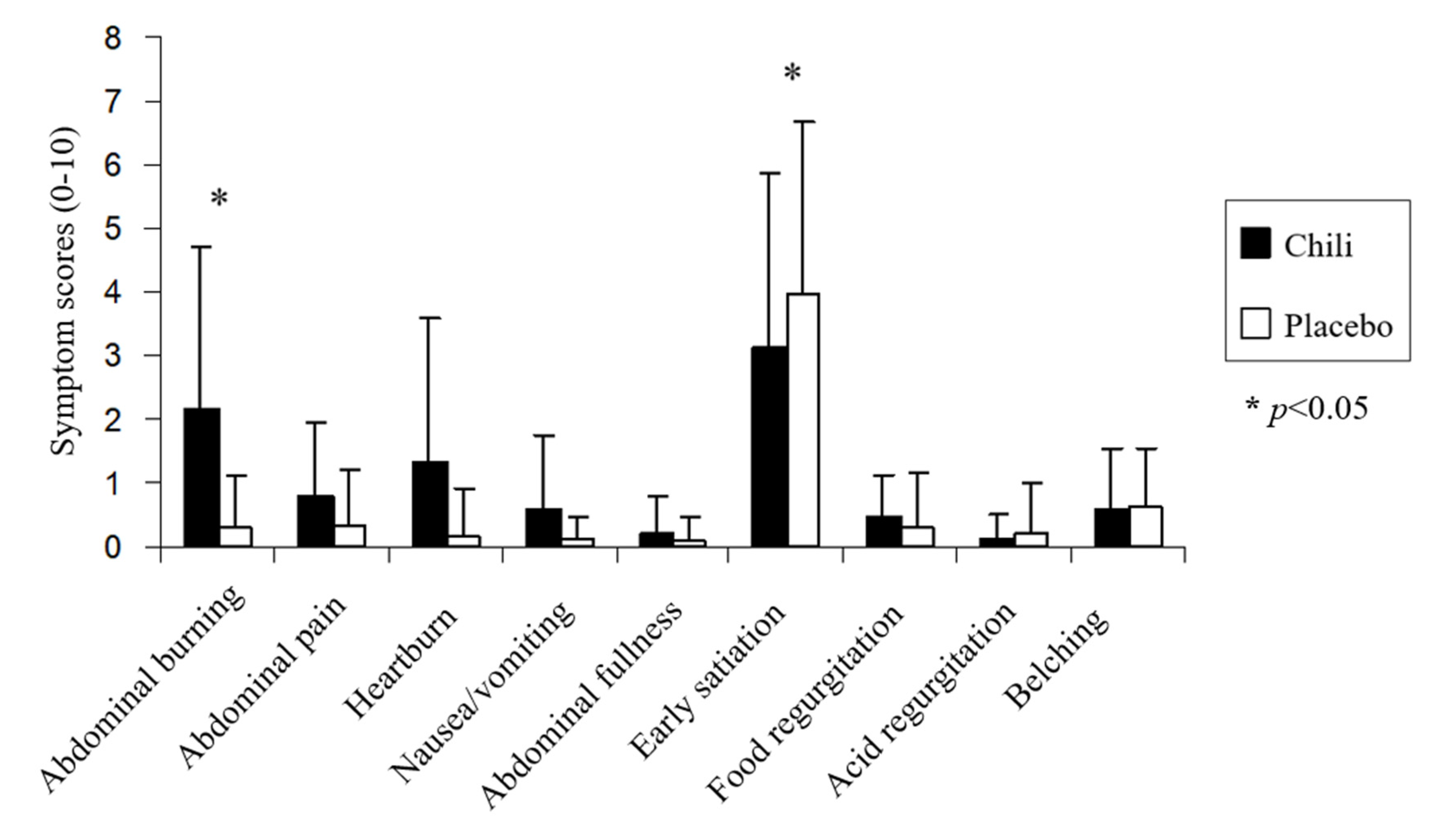
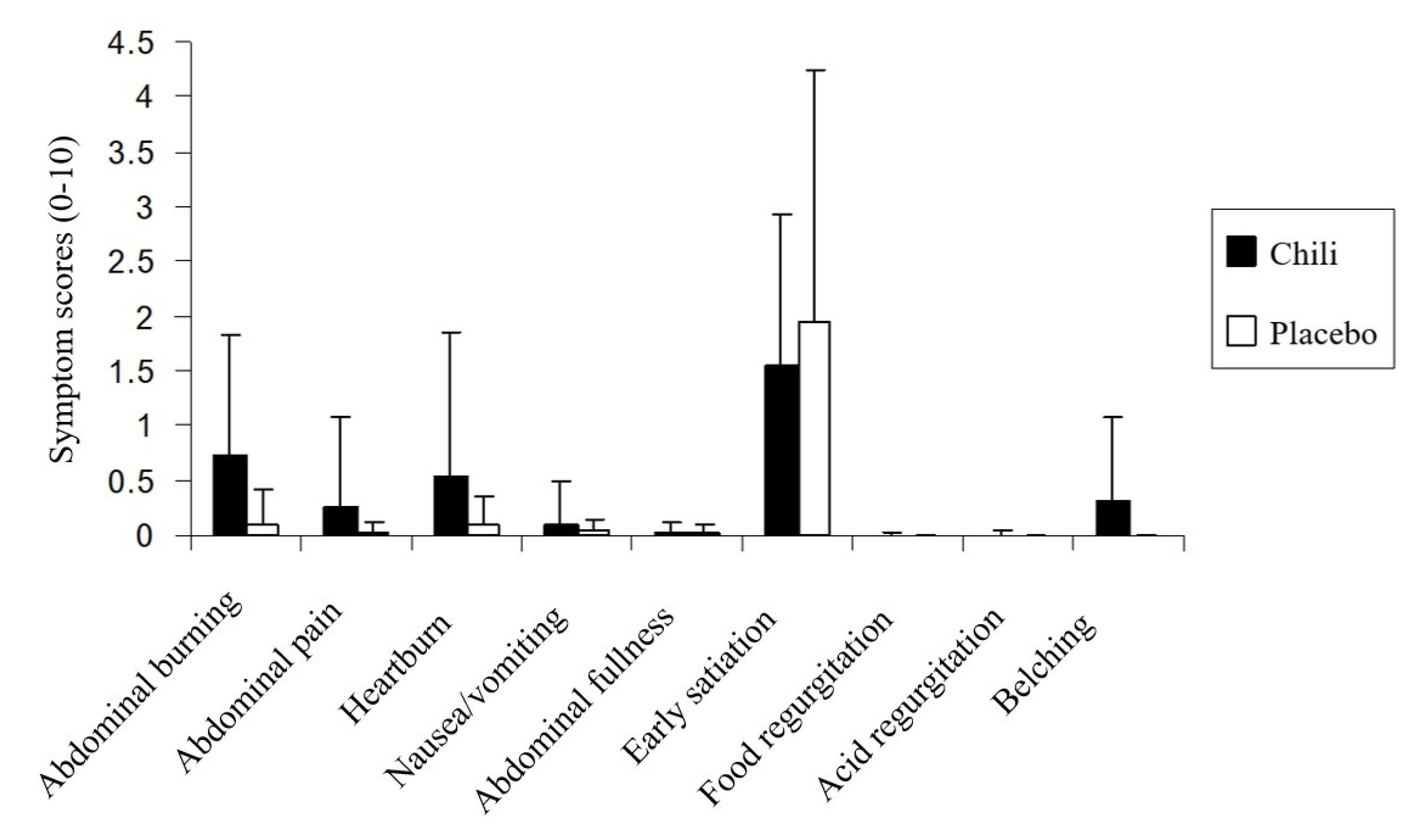
| Patients’ Characteristics | NERD (N = 15) | Healthy (N = 15) |
|---|---|---|
| Gender (male:female) | 7:08 | 7:08 |
| Age (years) | 48 ± 9 | 40 ± 13 |
| BMI (kg/m2) | 24.6 ± 4.3 | 24.3 ± 3.2 |
| Total % time pH < 4 | 9.7 ± 5.2 | - |
| Baseline gastric volume (ml) | 155.0 ± 39.3 | 148.5 ± 39.8 |
| Symptoms scores (VAS 0-10) | ||
| - Abdominal burning | 2.4 ± 2.9 ** | 0.08 ± 0.32 |
| - Abdominal pain | 2.4 ± 2.7 *** | 0 |
| - Heartburn | 1.5 ± 2.3 * | 0.03 ± 0.12 |
| - Nausea/vomiting | 0.54 ± 1.81 | 0.08 ± 0.33 |
| - Abdominal fullness | 2.5 ± 2.8 ** | 0.1 ± 0.4 |
| - Early satiation | 0.9 ± 2.1 | 0.3 ± 0.7 |
| - Food regurgitation | 1.4 ± 2.5 * | 0 |
| - Acid regurgitation | 0.5 ± 1.8 | 0 |
| - Belching | 1.8 ± 2.5 * | 0.2 ± 0.9 |
Publisher’s Note: MDPI stays neutral with regard to jurisdictional claims in published maps and institutional affiliations. |
© 2020 by the authors. Licensee MDPI, Basel, Switzerland. This article is an open access article distributed under the terms and conditions of the Creative Commons Attribution (CC BY) license (http://creativecommons.org/licenses/by/4.0/).
Share and Cite
Patcharatrakul, T.; Kriengkirakul, C.; Chaiwatanarat, T.; Gonlachanvit, S. Acute Effects of Red Chili, a Natural Capsaicin Receptor Agonist, on Gastric Accommodation and Upper Gastrointestinal Symptoms in Healthy Volunteers and Gastroesophageal Reflux Disease Patients. Nutrients 2020, 12, 3740. https://doi.org/10.3390/nu12123740
Patcharatrakul T, Kriengkirakul C, Chaiwatanarat T, Gonlachanvit S. Acute Effects of Red Chili, a Natural Capsaicin Receptor Agonist, on Gastric Accommodation and Upper Gastrointestinal Symptoms in Healthy Volunteers and Gastroesophageal Reflux Disease Patients. Nutrients. 2020; 12(12):3740. https://doi.org/10.3390/nu12123740
Chicago/Turabian StylePatcharatrakul, Tanisa, Chatchai Kriengkirakul, Tawatchai Chaiwatanarat, and Sutep Gonlachanvit. 2020. "Acute Effects of Red Chili, a Natural Capsaicin Receptor Agonist, on Gastric Accommodation and Upper Gastrointestinal Symptoms in Healthy Volunteers and Gastroesophageal Reflux Disease Patients" Nutrients 12, no. 12: 3740. https://doi.org/10.3390/nu12123740





